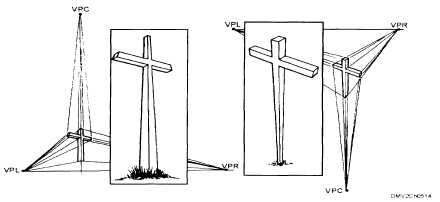Three-Point Perspective
Introduction
Three-point perspective is when no edge of the object is parallel to the
picture plane and all three dimensions (height, width, and depth) require
vanishing points.
Three-point perspective is also known as oblique
perspective.
You need a more sophisticated sense of perspective to
successfully create illustrations in three-point perspective.
Three-point or
In three-point or oblique perspective, the object is placed so that none of the
oblique
perspective
principal edges is parallel to the picture plane. All three edges require
separate vanishing points to determine height, width, and depth. The station
point is parallel to the picture plane and the cone of visual rays is
perpendicular to the picture plane. The decision on the placement of the
vanishing points is arbitrary and based purely on aesthetics. Here are two
general rules to follow in placing vanishing points in three-point perspective:
(1) separate vanishing points to make small objects look better and (2) place
vanishing points closer together to emphasize the expanse or large size
objects.
Figure 5-14 shows an object rendered in three-point perspective.
Figure 5-14.—Three-point perspective.
5-16


